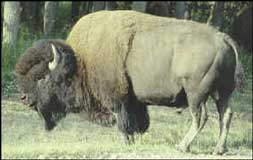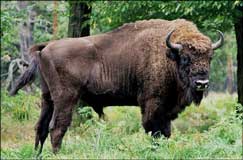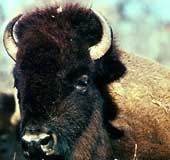Animal Facts
Bison
( Bison bison bison and Bison bison athabascae)
 The animal that people call a buffalo in North America and Canada is not really a buffalo - it's a bison.
The animal that people call a buffalo in North America and Canada is not really a buffalo - it's a bison.
The bison's correct name is the American Bison. It's also called the American buffalo because people still think it's a buffalo, even though it's not.
 The bison is related to the Wisent, or European Bison, found in north central Europe. The Wisent is an endangered species (not many of them are found today).
The bison is related to the Wisent, or European Bison, found in north central Europe. The Wisent is an endangered species (not many of them are found today).
Bison description
 Bison are the largest mammals in North America. They grow up to 2 metres tall (6.6 feet) and 3 metres long (10 feet), and weigh up to 400 kilograms (882 lb). Males are larger than females. The biggest bison have weighed up to 1,133 kilograms (2,500 lb).
Bison are the largest mammals in North America. They grow up to 2 metres tall (6.6 feet) and 3 metres long (10 feet), and weigh up to 400 kilograms (882 lb). Males are larger than females. The biggest bison have weighed up to 1,133 kilograms (2,500 lb).
Bison are ungulates, meaning they have hooves. They have a hump and huge heads and shoulders, and both males and females have short, curved horns.
There are two types of American Bison - the Wood Bison (Bison athabascae) and the Plains Bison (Bison bison bison).

The Wood Bison is larger and heavier, with a darker coat. Long strands of hair hang between its horns and it has a thinner beard and throat mane.
 The Plains Bison is smaller. It has thick wool like a cap, between its horns, a thick beard and a mane around its throat. Its coat is also lighter in colour.
The Plains Bison is smaller. It has thick wool like a cap, between its horns, a thick beard and a mane around its throat. Its coat is also lighter in colour.
Both types of bison have a long, shaggy, winter coat which comes off in clumps or patches in spring. Their summer coat is lighter weight and lighter coloured.


